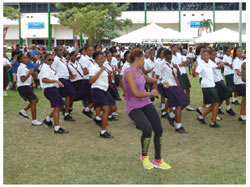 |
 |
 |
|
February 2014 |
The project was born to address concerns about low student performance in these areas, and was hoped to raise awareness about STEM education. It was designed and managed by the Continuing Professional Development and Outreach Unit of the SOE and involved mathematics and science educators there. This Unit extends the SOE’s outreach through teacher professional development workshops and programmes as well as special projects, such as this STEM education programme. While the final goal was to boost student interest in the subjects and provide an environment for creativity and innovation to flourish, the first major activity was training teachers. This was followed by a period of mentorship using online technology. The second major activity involved an intervention in the schools with the trained teachers.
Children at the pre-primary, primary and secondary levels shared their experiences and made live scheduled presentations in front of their peers. As students demonstrated either the process of deciding on the product on display or even the features of the product itself, they spoke confidently of what they did or what they had learnt. In addition to the children’s projects, there were several other STEM-related events. The campus grounds were ablaze with the vibrant colours of the different school uniforms of the 3+ to 17+ students who presented or visited on those days. The energy and excitement was surpassed only by the brilliant sunshine and the ambience of the JFK area, the quadrangle and the greens. In the open areas, students explored the physiology of movement with Zumba as others matched the physics involved with using stilts with two live colourful Moko Jumbies. Nearby, the UWI Robotics in Education team kept other groups of children engrossed in the technology of the robots displayed. In yet another area, students excitedly drew pictures of their STEMaginator scientist. The BG Science Bus and NIHERST also had very interactive sessions that explored a wide range of science and mathematics concepts.
Over the two days, more than 4500 children and an estimated 500 teachers, parents and members of the public attended. This high attendance would not have been possible without the assistance of Corporal Williams and his team from the Transport Division of the Police Service and by Defence Force volunteers, members of the Cadet Force and the Civilian Conservation Corps. On behalf of my team at the SOE, I wish to thank all those who generously enabled this project. 22 schools completed the journey
Dr Maria Byron is Coordinator of the Outreach Unit at the School of Education, which worked on this STEM Project. The team included: Dr Sabeerah Abdul-Majied, Dr Vimala Kamalodeen, Dr Zhanna Dedovets, Dr Joycelyn Rampersad, Mrs Juliana Alexander, Mrs Laila Boisselle, Mrs Nalini Ramsawak-Jodha, Mrs Sandra Figaro-Henry and Mrs Nicolin Moore. |

 Just under a year ago, in April 2013, 100 teachers from 25 pre-primary, primary and secondary schools throughout Trinidad got involved with an education project known as STEM (Science, Technology, Engineering and Mathematics), a partnership with BG T&T, and The UWI’s School of Education (SOE) in collaboration with the Ministry of Education
Just under a year ago, in April 2013, 100 teachers from 25 pre-primary, primary and secondary schools throughout Trinidad got involved with an education project known as STEM (Science, Technology, Engineering and Mathematics), a partnership with BG T&T, and The UWI’s School of Education (SOE) in collaboration with the Ministry of Education The final step was the STEM Children’s Conference, held over two days in mid-January, at the JFK Auditorium and Quadrangle, UWI, St Augustine. The event was truly unique as 62 teachers and their 1200 students from the 22 schools presented STEM projects. These had been completed during the September-December school term as part of the scheduled curriculum in Mathematics, Science, and IT.
The final step was the STEM Children’s Conference, held over two days in mid-January, at the JFK Auditorium and Quadrangle, UWI, St Augustine. The event was truly unique as 62 teachers and their 1200 students from the 22 schools presented STEM projects. These had been completed during the September-December school term as part of the scheduled curriculum in Mathematics, Science, and IT.  Simultaneously, in the Engineering Lecture Theatre and two other presentation areas, groups of students from the presenting classes made formal presentations of their projects that were on display in booths beautifully set up in tents and the JFK Auditorium. Students, as presenters, explained to their peers how they brainstormed their project ideas after identifying a problem. They confidently outlined the science and mathematics that they had learnt while designing and developing their products. These verbal presentations were truly inspiring and spoke to the achievements of these students and the dedication of their teachers. Without doubt, there is need to put the children centre stage more often; and what a better place than at The UWI!
Simultaneously, in the Engineering Lecture Theatre and two other presentation areas, groups of students from the presenting classes made formal presentations of their projects that were on display in booths beautifully set up in tents and the JFK Auditorium. Students, as presenters, explained to their peers how they brainstormed their project ideas after identifying a problem. They confidently outlined the science and mathematics that they had learnt while designing and developing their products. These verbal presentations were truly inspiring and spoke to the achievements of these students and the dedication of their teachers. Without doubt, there is need to put the children centre stage more often; and what a better place than at The UWI!